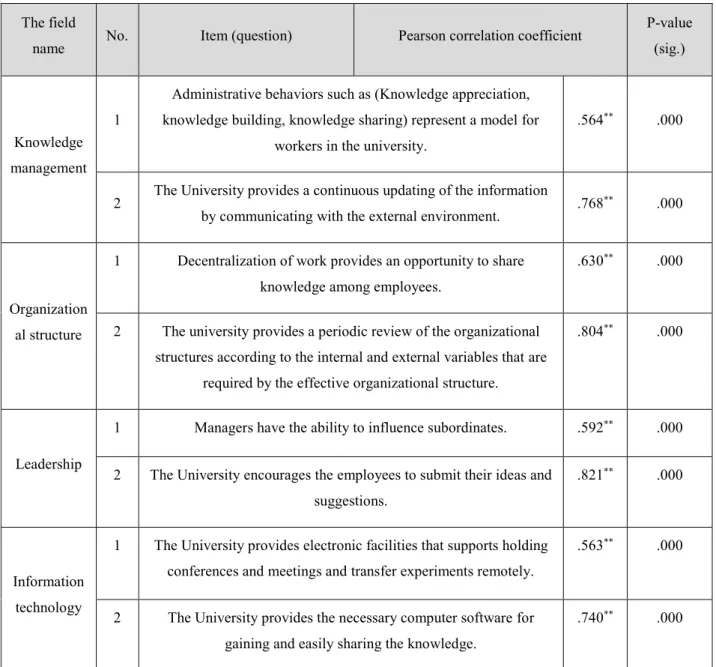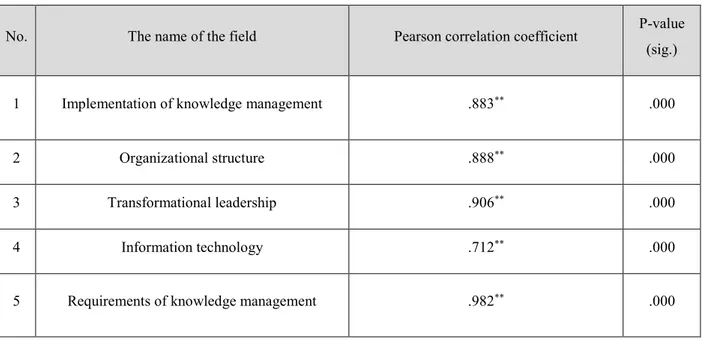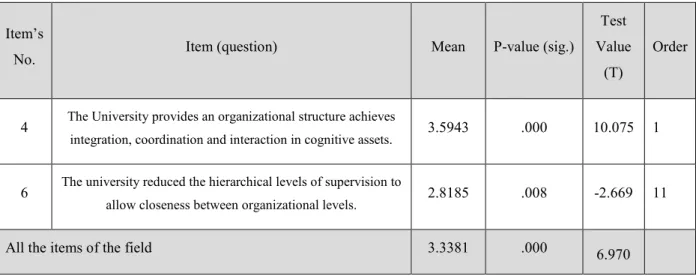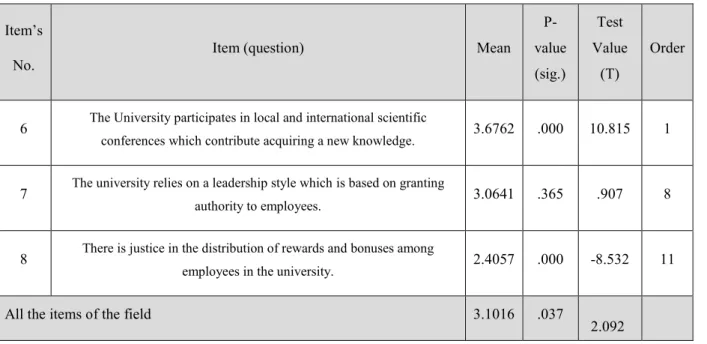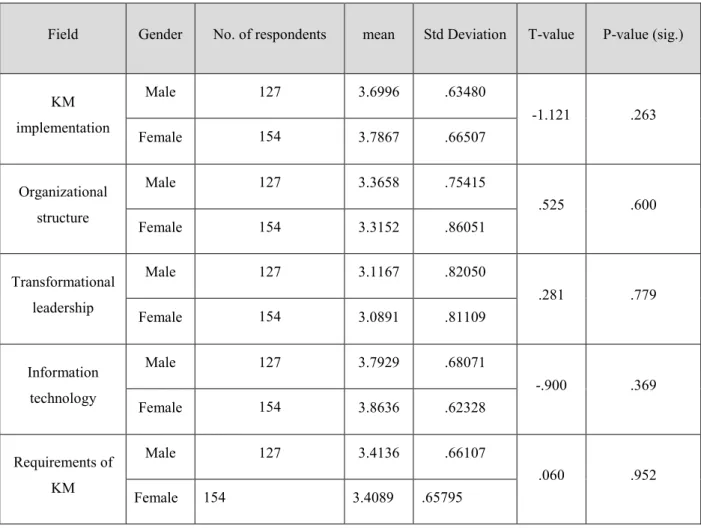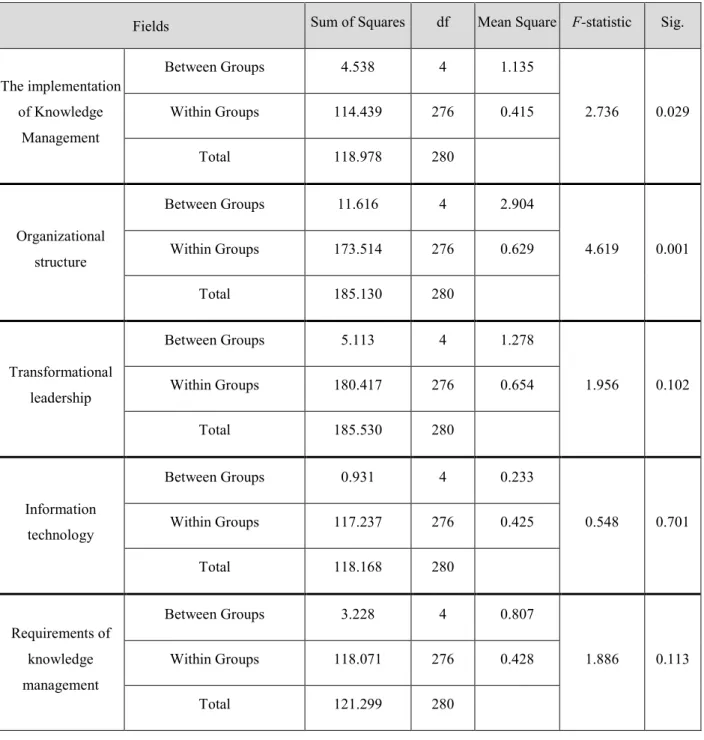Requirements Of Knowledge Management Implementation
In Istanbul Aydin University
Fady M. F. ABUGHAZI
1, Uğur ŞENER
2ABSTRACT
Knowledge is power. After knowledge has started to play an important role in organizations, this paper comes to prove the importance of knowledge management in the education sector. The study aims to explore the requirements of knowledge management implementation in Istanbul Aydin University in Turkey. The descriptive analytical approach is used, and the population of the study was the staff working in Istanbul Aydin University. The questionnaire was used as a tool for data collection. The collection of data was done by sending an online questionnaire to staff emails and distributing the questionnaires to the university’s staff by hand. 281 questionnaires were collected and analyzed statistically by SPSS program. The main conclusions of the study are that knowledge management assists Istanbul Aydin University to achieve their goals and that there is a positive relationship between the implementation of knowledge management and the requirements of knowledge management (organizational structure, leadership, information technology) in Istanbul Aydin University.
Keywords: KM, Knowledge management, requirements of KM, KM implementation
ÖZET
Bu çalışma İstanbul Aydın Üniversitesinde bilgi yönetimi uygulamalarını araştırmaktadır. Araştırmacı betimsel analitik yaklaşımı kullanmış ve araştırmanın popülasyonunu İstanbul Aydın Üniversitesindeki akademik personel ve idari personel oluşturmuştur. Anket veri toplama aracı olarak kullanılmıştır. Veri toplama işlemi iki yoldan tamamlanmıştır. İlk olarak, araştırmacı bir çevrimiçi anket tasarlamış ve üniversitenin e-postaları tarafından çalışan personele gönderilmiştir ve (30) çalışan personel çevrimiçi ankete cevap vermiştir. Araştırmacı, üniversitenin personeline anket formları dağıtılmıştır. (290) (%86.5) oranında (251) anket formu toplanmıştır. Araştırmanın sonuçlarına göre; bilgi yönetimi İstanbul Aydın Üniversitesi'nin hedeflerine ulaşmasına yardımcı oluyor ve bilgi yönetiminin uygulanması ile bilgi yönetimi gereklilikleri arasında (örgüt yapısı, liderlik bilgi teknolojisi) olumlu bir ilişki var.
Sonuçlar, İstanbul Aydın Üniversitesi'ndeki bilgi yönetimi (organizasyonel yapı, dönüşümsel liderlik ve bilgi teknolojisi) gereklilikleri arasında olumlu ilişkiyi göstermiştir. Bilgi teknolojisi (3.83) ortalama ile birinci sırada yer alırken, bunu (3.34) ortalama ile örgütsel yapı izlemiştir. Liderlik (3.10) ortalama ile üçüncü sıradadır. Bilgi Yönetimi ve organizasyon yapısı alanlarının uygulanmasında, katılımcıların, pozisyon nedeniyle bilgi yönetiminin uygulanması gereksinimleri ile ilgili olarak anlamlı istatistiksel farklılıkları olduğu tespit edilmiştir. Ayrıca, liderlik ve bilgi teknolojisi alanlarındaki konuma bağlı olarak yanıtlarda anlamlı istatistiksel farklılıkların olmadığı ve aynı zamanda cinsiyet ve yaş tecrübelerinden dolayı yanıtlarda önemli istatistiksel farklılıkların bulunmadığı ortaya konulmuştur. Bu araştırma, üniversitenin bilgi yönetimi alanında bir dizi seminer, konferans, atölye çalışması eğitim kursu ve konferans düzenlemeye dikkat edilmesi ve bilgi yönetimi bilgi paylaşım kültürü kazandırması gibi tavsiyelerde bulunmaktadır. İstanbul Aydın Üniversitesi, Bilgi yönetiminde yaratıcılık süreçleri geliştirmeyi, yeni yaratıcı fırsatları izleyerek ve bunlardan en iyisini seçerek değerlendirmelidir. Ayrıca, bilgi yönetimi faaliyetleri çalışanlar arasındaki rekabet için bir temel oluşturmalıdır.
Introduction
Knowledge is progressively being acknowledged as the new imperative strategy for organizations, and the capability to manage knowledge is becoming progressively more critical in today’s knowledge economy. The creation and propagation of knowledge have become increasingly significant factors in competitiveness. The emergence of the Knowledge Management (KM) definition started with Peter Drucker's famous quote (1993): "The basic economic resource is no longer natural resources, nor labor, nor capital. It is and will be knowledge”.
KM as an organizational innovation has been with us for more than a decade. As a discipline, it has reached a state of maturity where we can now discern the principles, practices, and tools that make it unique. As a discourse, it has engendered new concepts and categories for us to make sense of the many important ways that organizations use knowledge to create value (Dalkir, 2005).Thomas H. Davenport defined KM as "the process of capturing, distributing, and effectively using knowledge." KM is becoming increasingly important and effective in various sectors of society. Knowledge sharing is considered the most significant resource for assuring a continuous survival, existence and success for the organizations. This study explains and discusses the most important subjects that help the success of KM implementation. This study tries to answer the question which is “what are the requirements for the organizations to be successful in KM implementation” through studying the three diminutions that affect the implementation of KM which are “organizational culture, leadership and information technology”.
LITERATURE REVIEW
In this part, previous studies about knowledge management, organizational structure, transformational leadership and informational technology is presented.
1.1 Knowledge Management
Everyone manages. Managing our time, career, finance, relationship and life are considered as managerial behaviors. However, the complexity increases when the concepts of managing or being a manager are applied to an organization (Darr, 2010). The practice of management can be traced to the twentieth century, in spite of the importance of management in all business and humanitarian activities, however there is no clear agreement among experts and researchers in the field of management on the standard definition.
The definition of KM concept varies according to the changing of the entrances of the concept as well as the changes of the disciplines and the backgrounds of researchers and writers in this field. This contrast is also due to the breadth of KM concept or the rapid changes of the concept. KM can be defined as the exploitation of skills and expertise to facilitate the generation and sharing of knowledge among the members of the organization through group working and seeking for the necessary information to achieve the objectives of the organization.
There are so many features for the organizations that operate the concept of KM. Organizations of KM use the scientific research methods and other systemic methods as a basis for planning, thinking and decision-making. And also, they seek to ensure the development of knowledge from various internal and external sources, and the continuous updating of the available knowledge. They also use the current available knowledge appropriately in setting goals and objectives in addition to the high-speed rate of processes of creativity, innovation and the development of products and services.
1.2 Organizational Structure
The most appropriate organizational structures for the implementation of KM in organizations are structures that help to develop the spirit of teamwork that is characterized by flexibility, and continuity and sharing of knowledge at all levels of the organization.
KM can be successfully implemented by an organization when they know their needed knowledge. Even though, some of the best practices of KM can be transferred among organizations, internal and external situation of the organization should be taken seriously and KM activities should be adjusted to it (Mládková, 2011).
The type of organizational structure is a critical factor that influences the success of the organization with any KM activities. Nonaka and Takeuchi (1995) classified three types of organizational structures, and these structures are; the bottom-up structures, top-down structures and combined structures (Mládková, 2011).The best structure which helps the implementation of KM is the combined structure because it is a hybrid structure, thus organizations can use the benefits of the advantages of bottom-up and top-down structures and crush the disadvantages.
1.3 Transformational Leadership
Leaders are strongly effective in the practices of KM. What leaders could do for making this factor more effective is to share their individual knowledge and also to fulfill and promote their knowledge skills (Gelard & Boroumand, 2014). Transformational leadership ables to function such an important role in promoting the environment of organizations and it can help to apply knowledge efficiently by managing the knowledge in the desired way to improve the organizational learning (Aragón-Correa, J. A., García-Morales, V. J., & Cordón-Pozo, 2007).
All of the transformational leaders have the same common attribute that all of them try and attempt to encourage their followers to involve a higher degree of KM (Bryant, 2003). Transformational leaders improve an environment which aids to create, share, maintain, and imply knowledge. Especially, transformational leaders by using advantages of the mental inspiration, ideal and developmental support to inspire their followers to generate and share knowledge. Podsakoff, Mackenzie, and Bommer (1996) declared that transformational leaders generate and invent original ideas and support the workers in applying these ideas to develop the process of production. According to this, it has been noticed that there is a positive relationship between transformational leadership and the employees' performance. Eventually, organizations encourage innovative performance among the employees to support knowledge creation (Birasnav & Rangnekar, 2011).
In general, KM’s behaviors can be predicted by transformational leaders, and they function a very significant role in implying and managing KM. Those leaders show the same view and generate functional solutions to inspire the followers to make them more taking a part in the activities of KM. Transformational leaders prepare lower- level individuals with information competencies, motivation, skills and duties that assist them to inspire, gain, create, share, keep and imply knowledge.
1.4 Information Technology
Prusak and Davenport (1998), the core role of IT in KM is to quicken the rapidity of transferring knowledge. The software of KM advocates the flow of knowledge through communities and networks. The tools of KM aim to help the practices of organizing and gathering the knowledge of groups of individuals to make the knowledge obtainable in a shared base. The use of modern information technology to get the best results is the main requirement for organizations that want to be at the forefront. KM needs to apply IT in order to improve creating, organizing, sharing and applying knowledge. Therefore, these technological tools are too important and without them the organizations cannot apply and practice the KM to the fullest. IT is playing an important role in easing the implementing of KM in organizations.
Today, numerous tools are available under the umbrella of KM. The discovery of knowledge by technological tools makes it very effective for those organizations that want to get a sustainable competitive advantage. Technology plays an important role in the management of knowledge, as in knowledge generation, acquisition, sharing and storing. Thus the role of technology in KM can be summed up with the following points:
KM is often facilitated by information technology.
Supports the interaction of resources for the generation of new knowledge. Increases the “capability” and “efficiency” of KM by IT tools.
Provides solutions for KM.
Provides several means to facilitate the formation of joint workshops.
METHODOLOGY
A descriptive study, in addition to a statistical analysis, is used to describe and evaluate the requirements of KM implementation in the IAU. A questionnaire was used to test and analyze the requirements of KM implementation. The study represents a population of working staff including deans, administration staffs, head of departments and academics in IAU, however, 30 of working staff members answered the online questionnaire and 251 collected questionnaire by hand and the number of the collected questionnaires was 281.
A Likert scale was used to measure respondents' responses to the questions of the questionnaire. The questionnaire was composed of two parts: first part was aimed at collecting personal and professional information including, gender, job title and years of work. Second part was aimed at measuring the implementation of KM and the requirements of KM implementation (organizational structure, transformational leadership and information technology).
Kolmogorov-Smirnov test was used to make sure if the collected data was distributed according to a normal distribution or not. The next table shows the result of the test.
Table 2.1 One Sample Kolmogorov-Smirnov Test
Field P-value (sig.)
All Fields of the Questionnaire 0.0826
A Pearson correlation coefficient test was used to the internal and structure scale of the questionnaire. The results of the internal scale show the positive relationship between each element of the questionnaire and all elements of entire fields. Table (2.2) shows the lowest and the highest values of correlation for the elements of each field.
Table 2.2 The correlation coefficient (internal scale)
The field
name No. Item (question) Pearson correlation coefficient
P-value (sig.)
Knowledge management
1
Administrative behaviors such as (Knowledge appreciation, knowledge building, knowledge sharing) represent a model for
workers in the university.
.564** .000
2 The University provides a continuous updating of the information
by communicating with the external environment. .768** .000
Organization al structure
1 Decentralization of work provides an opportunity to share knowledge among employees.
.630** .000
2 The university provides a periodic review of the organizational structures according to the internal and external variables that are
required by the effective organizational structure.
.804** .000
Leadership
1 Managers have the ability to influence subordinates. .592** .000
2 The University encourages the employees to submit their ideas and suggestions.
.821** .000
Information technology
1 The University provides electronic facilities that supports holding conferences and meetings and transfer experiments remotely.
.563** .000
2 The University provides the necessary computer software for gaining and easily sharing the knowledge.
.740** .000
Also, table (2.3) shows structure validity results which are the coefficient relation between each field of the questionnaire and the whole fields.
Table 2.3 The correlation coefficient between each field of the questionnaire and the whole fields
No. The name of the field Pearson correlation coefficient P-value (sig.)
1 Implementation of knowledge management .883** .000
2 Organizational structure .888** .000
3 Transformational leadership .906** .000
4 Information technology .712** .000
5 Requirements of knowledge management .982** .000
In addition, in the table (2.4) a Cronbach's Alpha test was used to measure the reliability of the questionnaire and the results show a good and mostly a very high consistency.
Table 2.4 Cronbach's Alpha for Reliability
No. The name of the field No. of
Items Cronbach's Alpha coefficient 1 Knowledge management 13 .893
2 Organizational structure 11 .914
3 Leadership 11 .902
4 Information technology 10 .857 5 Requirements of knowledge management 32 .945
RESULTS
A Statistical analysis of the collected data from the questionnaire by using a statistical software program (SPSS) was performed to reach the results of the study that will be presented and analyzed.
One-Sample T-test was used to determine the statistical mean of each question and then compare the results with the neutrality degree of (3) and at the end conclude if the response to a questionnaire’s item was equal to the neutrality degree of 3 or significantly differ from it.
Table 3.1 One-Sample T test mean and P-value (sig.) of the implementation KM field
Item’s
No. Item (question) Mean P-value (sig.)
Test Value
(T)
Order
2 Knowledge management helps in achieving the objectives of
the university. 4.1281 .000 21.868 1
13 The University seeks to attract highly skilled and qualified
people from outside to help in generating knowledge. 3.3630 .000 5.072 13 All the items of the field 3.7473 .000 19.218
Table 3.1 shows the result of one sample T test for KM implementation field. The second question of the field placed as the highest accepted question and thirteenth question placed as the lowest accepted question. However, the results of all the items of the field show a general acceptance for the field of KM implementation.
Table 3.2 One-Sample T test mean and P-value (sig.) of dominant organizational structure field.
Item’s
No. Item (question) Mean P-value (sig.)
Test Value
(T)
Order
4 The University provides an organizational structure achieves
integration, coordination and interaction in cognitive assets. 3.5943 .000 10.075 1
6 The university reduced the hierarchical levels of supervision to
allow closeness between organizational levels. 2.8185 .008 -2.669 11
Table 3.2 shows the result of one sample T test for the organizational structure filed. The fourth question of the field placed as the highest accepted question and sixth question placed as the lowest accepted question. However, the results of all the items of the field show a general acceptance for the field of the organizational structure.
And also, table 3.3 shows the result of one sample T test of the leadership field. The sixth question of the field placed as the highest accepted question and eighth question placed as the lowest accepted question. In contrast, the results show that the sample didn’t agree on some questions of this field, and we can see that there is a higher disagreement on the seventh question with a p-value of .365 which is way over than the level of significance, .05. However, the results of all the items of the field show a general acceptance for the field of leadership.
Table 3.3 One-Sample T test mean and P-value (sig.) of dominant transformational leadership Field
Item’s
No. Item (question) Mean
P-value (sig.) Test Value (T) Order
6 The University participates in local and international scientific
conferences which contribute acquiring a new knowledge. 3.6762 .000 10.815 1
7 The university relies on a leadership style which is based on granting
authority to employees. 3.0641 .365 .907 8
8 There is justice in the distribution of rewards and bonuses among
employees in the university. 2.4057 .000 -8.532 11
All the items of the field 3.1016 .037
2.092
Table 3.4 shows the result of one sample T test for the information technology field. The third question of the field placed as a highest accepted question and sixth question placed as the lowest accepted question. However, the results of all the items of the field show a general acceptance for the field of information technology.
Table 3.4 One-Sample T test mean and P-value (sig.) of dominant information technology field
Item’s
No. Item (question) Mean
P-value (sig.) Test Value (T) Order
3 Mainstreaming of the internet connection service for employees at all
levels in the university. 4.2420 .000 24.913 1
6 The University provides electronic facilities that supports holding
conferences and meetings and transfer experiments remotely. 3.6228 .000 10.402 10
All the items of the field 3.8317 .000
21.460
Table 3.5 shows the correlation coefficient between KM and the requirements of KM equals .779** and the p-value
(sig.) equals 0.000 which is less than (α = 0.05). This result confirms a positive and statistical significance between the requirements of KM and the implementation of KM in IAU.
Table 3.5 The correlation coefficient between KM and KM requirements
Fıeld Pearson correlation coefficient P-value (sig.) Organizational structure .764** .000
Transformational leadership .683** .000
Information technology .531** .000
Table 3.6 Two independent samples T-Test for testing the differences due to gender
Field Gender No. of respondents mean Std Deviation T-value P-value (sig.)
KM implementation Male 127 3.6996 .63480 -1.121 .263 Female 154 3.7867 .66507 Organizational structure Male 127 3.3658 .75415 .525 .600 Female 154 3.3152 .86051 Transformational leadership Male 127 3.1167 .82050 .281 .779 Female 154 3.0891 .81109 Information technology Male 127 3.7929 .68071 -.900 .369 Female 154 3.8636 .62328 Requirements of KM Male 127 3.4136 .66107 .060 .952 Female 154 3.4089 .65795
The results of Table 3.6 purely show that opinions regarding gender make no difference in the study. The results indicate to accept the sub-hypothesis which indicates that there are no differences among the respondents in their opinions over the study fields attributed to gender.
The results of Table 3.7 show that there are statistically significant differences among the respondents on the implementation of KM and organizational structure fields due to the job title variable. And also it shows that there are no statistically significant differences among the respondents on transformational leadership, information technology and requirements of KM fields due to the job title variable.
Table 3.7 Analysis of variance (Job-title variable)
Fields Sum of Squares df Mean Square F-statistic Sig.
The implementation of Knowledge Management Between Groups 4.538 4 1.135 2.736 0.029 Within Groups 114.439 276 0.415 Total 118.978 280 Organizational structure Between Groups 11.616 4 2.904 4.619 0.001 Within Groups 173.514 276 0.629 Total 185.130 280 Transformational leadership Between Groups 5.113 4 1.278 1.956 0.102 Within Groups 180.417 276 0.654 Total 185.530 280 Information technology Between Groups 0.931 4 0.233 0.548 0.701 Within Groups 117.237 276 0.425 Total 118.168 280 Requirements of knowledge management Between Groups 3.228 4 0.807 1.886 0.113 Within Groups 118.071 276 0.428 Total 121.299 280
Table 3.8 The analysis of variance (Experience variable)
Fields Sum of Squares df Mean Square F-statistic Sig.
The implementation of knowledge management Between Groups .575 3 .192 .448 .719 Within Groups 118.403 277 .427 Total 118.978 280 Organizational structure Between Groups 1.375 3 .458 .691 .558 Within Groups 183.755 277 .663 Total 185.130 280 Transformational leadership Between Groups 2.353 3 .784 1.186 .315 Within Groups 183.177 277 .661 Total 185.530 280 Information technology Between Groups 1.214 3 .405 .958 .413 Within Groups 116.955 277 .422 Total 118.168 280 Requirements of knowledge management Between Groups 1.374 3 .458 1.058 .367 Within Groups 119.925 277 .433 Total 121.299 280
It can be concluded from Table 3.8 that there are no statistically significant differences among the respondents on these fields due to the experience variable.
CONCLUSION
The results show the positive relationship between the requirements of KM (organizational structure, transformational leadership and information technology) and the implementation of KM in IAU. In addition, the study identifies that there are no differences among the respondents in their opinions over the requirements of KM implementation attributed to gender and years of experience. The study detected that there are significant statistical differences in the implementation of knowledge management and organizational structure fields between the answers of the respondents concerning the requirements of implementing knowledge management due to the position (job-title). The study also detected that there are no significant statistical differences in the respondents’ opinions in the transformational leadership, information technology and requirements of KM fields due to position (job-title).
RECOMMENDATIONS
The university should pay attention to hold a series of seminars, lectures, workshops, training courses and conferences in the field of KM in order to raise awareness, create a culture of KM and enable the exchange of information and experiences in this field. The university also should hold workshops to explain to the employees their rights in this respect and give them information about its regulations and laws. And also, they should make the practice of KM activities a basis for the competition among employees.
Next, the University should encourage its employees to share their ideas and suggestions by interacting with them and rewarding them for their significant ideas. The university should keep up with the management methods, methodologies and practices that are related to KM to improve, develop and invest the knowledge which is available in its human resources and pay attention to their knowledge as a great wealth that increases its success or turns its failure into success.
REFERENCES
[1] Aragón-Correa, J. A., García-Morales, V. J., & Cordón-Pozo, E. (2007). Leadership and organizational learning’s role in innovation and performance: Lessons from Spain. Industrial Marketing Management, 36(3), 349–359. http://doi.org/10.1016/j.indmarman.2005.09.006
[2] Birasnav, M., & Rangnekar, S. (2011). Transformational leadership and human capital benefits: The role of knowledge management. Leadership &. Retrieved from
http://www.emeraldinsight.com/doi/pdf/10.1108/01437731111112962
[3] Bryant, S. E. (2003). The role of transformational and transactional leadership in creating, sharing and exploiting organizational knowledge. Journal of Leadership & Organizational Studies, 9(4), 32. http://doi.org/10.1177/107179190300900403
[4] Dalkir, K. (2005). Knowledge Management in Theory and Practice. Butterworth-Heinemann (Vol. 4). http://doi.org/10.1002/asi.21613
[5] Darr, K. (2010). Introduction to Management and Leadership Concepts, Principles, and Practices. Jone &
Bartlett Learning.
[6] Gelard, P., & Boroumand, Z. (2014). The relationship between transformational leadership and knowledge management. International Journal of. Retrieved from http://heartlandcircle.com/TLC/Capella_Study/TL and Knowledge Mgmt.pdf
[7] Mládková, L. (2011). Analyze Of Interrelation Between Knowledge Management And Organizatıonal Structure Of Organization. Bilgi Ekonomisi ve Yönetimi Dergisi. Retrieved from
